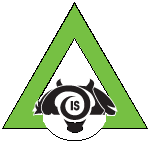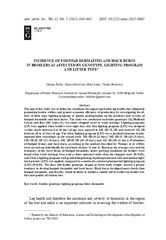Приказ основних података о документу
Incidence of footpad dermatitis and hock burns in broilers as affected by genotype, lighting program and litter type
| dc.creator | Škrbić, Zdenka | |
| dc.creator | Pavlovski, Zlatica | |
| dc.creator | Lukić, Miloš | |
| dc.creator | Petričević, Veselin | |
| dc.date.accessioned | 2018-12-14T15:07:34Z | |
| dc.date.available | 2018-12-14T15:07:34Z | |
| dc.date.issued | 2015 | |
| dc.identifier.issn | 2300-8733 | |
| dc.identifier.uri | http://r.istocar.bg.ac.rs/handle/123456789/449 | |
| dc.description.abstract | The aim of this study was to define the conditions for improving broiler leg health, thus ultimately promoting broiler welfare and greater economic efficiency of production, by investigating the effects of litter type, lighting program, or genetic predisposition on the incidence and severity of footpad dermatitis and hock burns. The study was conducted on broiler genotypes (G) Hubbard Classic and Ross 308. Litter (L) was either chopped straw or wood shavings. Lighting programs (LP) were applied when broilers were eight days old. One lighting program (LP1) was designed so that chicks between 8 to 39 days of age were exposed to 16L:4D:2L:2D, and received 23L:1D between 40 to 42 days of age. The other lighting program (LP2) was a gradual extension of photoperiod after restrictions in the second week: 16L:8D (8-14 days), 16L:3D:2L:3D (15-21 days), 16L:2D:4L:2D (22-28 days), 16L:1D:6L:1D (29-35 days) and 23L:1D (36-42 days). Evaluations of footpad lesions and hock burn, according to the method described by Thomas et al. (2004), were carried out individually for each bird, on days 21 and 42. Based on the average score and the frequency of the worst forms of footpad dermatitis, better growing conditions for broilers were found when wood shavings were used as litter material rather than the chopped straw (P (lt) 0.01), and when a lighting program with gradual lengthening of photoperiod and with intermittent light/dark periods (LP2) was applied, compared to a moderate-constant photoperiod lighting program (LP1) (P (lt) 0.01). The Ross 308 broiler genotype, despite its lower body weight, showed a greater tendency to develop footpad dermatitis and hock burns. Hock burns developed more slowly than footpad dermatitis, and thereby, would be likely to exhibit a smaller adverse effect on broiler welfare and quality of chicken feet. | en |
| dc.publisher | De Gruyter Open Ltd, Warsaw | |
| dc.relation | info:eu-repo/grantAgreement/MESTD/Technological Development (TD or TR)/31033/RS// | |
| dc.rights | openAccess | |
| dc.source | Annals of Animal Science | |
| dc.subject | broiler | en |
| dc.subject | genotype | en |
| dc.subject | lighting program | en |
| dc.subject | litter | en |
| dc.subject | dermatitis | en |
| dc.title | Incidence of footpad dermatitis and hock burns in broilers as affected by genotype, lighting program and litter type | en |
| dc.type | article | |
| dc.rights.license | ARR | |
| dcterms.abstract | Павловски, Златица; Лукић, Милош; Петричевић, Веселин; Шкрбић, Зденка; | |
| dc.citation.volume | 15 | |
| dc.citation.issue | 2 | |
| dc.citation.spage | 433 | |
| dc.citation.epage | 445 | |
| dc.citation.other | 15(2): 433-445 | |
| dc.citation.rank | M23 | |
| dc.identifier.doi | 10.1515/aoas-2015-0005 | |
| dc.identifier.fulltext | http://r.istocar.bg.ac.rs//bitstream/id/2189/447.pdf | |
| dc.identifier.scopus | 2-s2.0-84929088615 | |
| dc.identifier.wos | 000353595700012 | |
| dc.type.version | publishedVersion |


